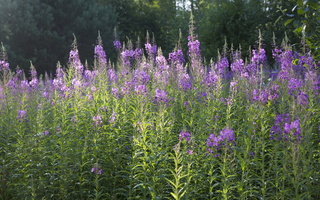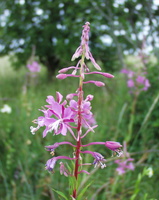- sort orderDefault
Photo title, A → Z
Photo title, Z → A
✔ Date created, new → old
Date created, old → new
Date posted, new → old
Date posted, old → new
Visits, high → low
Random
 home / Plantae · augalai / Onagraceae · nakvišiniai / Epilobium angustifolium · siauralapė ožkarožė
home / Plantae · augalai / Onagraceae · nakvišiniai / Epilobium angustifolium · siauralapė ožkarožė

Epilobium angustifolium · siauralapė ožkarožė
≡ Chamerion angustifolium, Chamaenerion angustifolium
EN · rosebay willowherb, fireweed, great willowherb
DE · Schmalblättrige Weidenröschen
LT · siauralapė ožkarožė, gaurometis, ožrožė
LV · šaurlapu kazroze
PL · wierzbówka kiprzyca
It is native throughout the temperate Northern Hemisphere. The name Fireweed derives from the species' abundance as a coloniser on burnt sites after forest fires. Its tendency to quickly colonize open areas of disturbed ground with little competition, such as sites of forest fires and forest clearings, makes it a clear example of a pioneer species.
The radially symmetrical flowers have four magenta to pink petals, 2 to 3 cm in diameter. The styles have four stigmas, which occur in symmetrical terminal racemes. The leaves of fireweed are unique in that the leaf veins are circular and do not terminate on the edges of the leaf, but form circular loops and join together inside the outer leaf margins. This feature makes the plants very easy to identify in all stages of growth.
The reddish-brown linear seed capsule splits from the apex. It bears many minute brown seeds, about 300 to 400 per capsule and 80,000 per plant. The seeds have silky hairs to aid wind dispersal and are very easily spread by the wind. Once established, the plants also spread extensively by underground roots, an individual plant eventually forming a large patch.
Young shoots, peeled stems, roasted roots (remove the bitter brown thread in the middle) are edible.
https://en.wikipedia.org/wiki/Chamaenerion_angustifolium
Division: Magnoliophyta
Class: Magnoliopsida
Order: Myrtales
Family: Onagraceae (Nakvišiniai)
Genus: Epilobium (Gaurometis)

